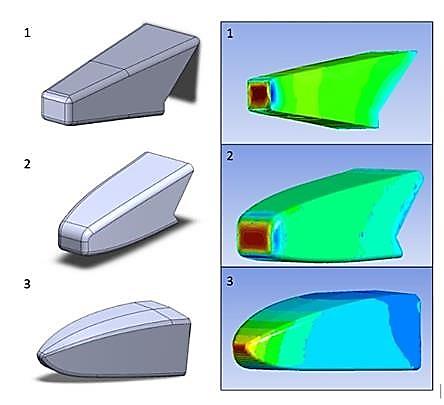Numerical Optimization for Aerodynamic Performance of Nose Cone of FSAE Vehicle through CFD
DOI:
https://doi.org/10.37934/cfdl.15.11.161171Keywords:
Optimization, Aerodynamic, Nose Cone, CFDAbstract
This paper presents the optimization and aerodynamic performance of a Formula SAE vehicle nose cone. The purpose of the study is to minimize drag while simultaneously enhancing downforce to improve traction and acceleration of the vehicle. Numerous CAD models of the nose cone were developed, taking into account factors such as chassis dimensions, ground clearance, and Formula SAE rulebook constraints. Computational Fluid Dynamics (CFD) analysis is carried out in ANSYS 2021 Fluent module. The fluid domain was created and meshed using tetrahedral cells, and the flow field was predicted using the Realizable k-ε turbulence model. The simulation results revealed essential information including drag and lift coefficients, as well as pressure and velocity contours. An in-depth analysis of lift and drag coefficients guided the optimization of the nose cone design. The study ultimately identified a nose cone design that yielded the most favorable drag coefficient and is found in the range between 0.2-0.3. The study also observed that the down force is increased by 27%. This design proved highly effective in reducing the vehicle's drag and sufficient downforce to enhance acceleration.
Downloads
References
Guerrero, Alex, Robert Castilla, and Giorgio Eid. "A numerical aerodynamic analysis on the effect of rear underbody diffusers on road cars." Applied Sciences 12, no. 8 (2022): 3763. https://doi.org/10.3390/app12083763
Stucki, Chad L., and Daniel Maynes. "Drag reducing nose fairings for existing freight train locomotives." Advances in Aerodynamics 4, no. 1 (2022): 37. https://doi.org/10.1186/s42774-022-00131-z
Borello, G., S. Beccio, S. Limone, G. Ferro, P. Bergamini, and F. B. Quagliotti. The role of the moving ground for automotive wind tunnel testing on race cars. No. 1999-01-0647. SAE Technical Paper, 1999. https://doi.org/10.4271/1999-01-0647
Blocken, Bert, and Yasin Toparlar. "A following car influences cyclist drag: CFD simulations and wind tunnel measurements." Journal of Wind Engineering and Industrial Aerodynamics 145 (2015): 178-186. https://doi.org/10.1016/j.jweia.2015.06.015
Nath, Devang S., Prashant Chandra Pujari, Amit Jain, and Vikas Rastogi. "Drag reduction by application of aerodynamic devices in a race car." Advances in Aerodynamics 3 (2021): 1-20. https://doi.org/10.1186/s42774-020-00054-7
Peng, Haibing. "A method for evaluation of aerodynamic lift and drag based on statistical mechanics." Physics of Fluids 35, no. 5 (2023). https://doi.org/10.1063/5.0146386
Gupta, A. (2018). Cost Effective Manufacturing and Optimization of the Formula Student Nose Cone, IRJET.
Oxyzoglou, Ioannis. "Design & development of an aerodynamic package for a FSAE race car." University Of Thessaly, pág 38 (2017).
Islam, Md Saifi Bin, Muhammad Faiz Ahmed, and Abdullah Al Saad. "Numerical Investigation on the Aerodynamic Characteristics of a Wing for Various Flow and Geometrical Parameters." Malaysian Journal on Composites Science and Manufacturing 12, no. 1 (2023): 13-30. https://doi.org/10.37934/mjcsm.12.1.1330.
Zhang, Zhe, Qiang Wang, Shida Song, Chengchun Zhang, Luquan Ren, and Yingchao Zhang. "Joint research on aerodynamic characteristics and handling stability of racing car under different body attitudes." Energies 15, no. 1 (2022): 393. https://doi.org/10.3390/en15010393
Munir, Fudhail Abdul, Muhammad Najhi Fauzi, and Ridhwan Jumaidin. "Numerical Study of The Effects of Vehicle Arrangement on Aerodynamics Resistance." Journal of Advanced Research in Fluid Mechanics and Thermal Sciences 98, no. 1 (2022): 67-72. https://doi.org/10.37934/arfmts.98.1.6772.
Hoque, Md Araful, Md Saifur Rahman, Khairun Nasrin Rimi, Abdur Rahman Alif, and Mohammad Rejaul Haque. "Enhancing formula student car performance: Nose shape optimization via adjoint method." Results in Engineering 20 (2023): 101636. https://doi.org/10.1016/j.rineng.2023.101636
Kwak, Minho, Suhwan Yun, Yeongbin Lee, Hyeokbin Kwon, Kyuhong Kim, and Dong-Ho Lee. "Optimum nose shape of a front-rear symmetric train for the reduction of the total aerodynamic drag." Journal of Mechanical Science and Technology 27 (2013): 3733-3743. https://doi.org/10.1007/s12206-013-0918-9
Nishikawa, Hiroaki. "Beyond interface gradient: a general principle for constructing diffusion schemes." In 40th fluid dynamics conference and exhibit, p. 5093. 2010. https://doi.org/10.2514/6.2010-5093
Fellows, Neil A. "Experimental modeling of a formula student carbon composite nose cone." Materials 10, no. 6 (2017): 620. https://doi.org/10.3390/ma10060620
Lee, Minhyung, Gwanyong Park, Changyoung Park, and Changmin Kim. "Improvement of grid independence test for computational fluid dynamics model of building based on grid resolution." Advances in Civil Engineering 2020 (2020): 1-11. https://doi.org/10.1155/2020/8827936
Anuar, Kaspul, and Agung Soegihin. "Aerodynamic Analysis of Unnamed Aerial Vehicle Serindit V-2 Using Computational Fluid Dynamics." Journal of Advanced Research in Fluid Mechanics and Thermal Sciences 93, no. 1 (2022): 83-93. https://doi.org/10.37934/arfmts.93.1.8393.
Wang, Shuguang, and Yonghwan Kim. "Adaptive grid deformation method for CFD application to hull optimization." In IOP Conference Series: Materials Science and Engineering, vol. 1288, no. 1, p. 012043. IOP Publishing, 2023. http://doi.org/10.1088/1757-899X/1288/1/012043
Wu, Zhengren, Shuguang Li, Mei Liu, Songling Wang, Hongyue Yang, and Xiujun Liang. "Numerical research on the turbulent drag reduction mechanism of a transverse groove structure on an airfoil blade." Engineering Applications of Computational Fluid Mechanics 13, no. 1 (2019): 1024-1035. https://doi.org/10.1080/19942060.2019.1665101
Bryant, Daniel John Ebrahim, and K. C. Ng. "Numerical modelling of hydraulic jump using mesh-based cfd method and its comparison with lagrangian moving-grid approach." Journal of Advanced Research in Micro and Nano Engineering 10, no. 1 (2022): 1-6.
Moradi, R., M. Mosavat, M. Barzegar Gerdroodbary, A. Abdollahi, and Younes Amini. "The influence of coolant jet direction on heat reduction on the nose cone with Aerodome at supersonic flow." Acta astronautica 151 (2018): 487-493. https://doi.org/10.1016/j.actaastro.2018.06.026
Edalatpour, Amirhossein, A. Hassanvand, M. Barzegar Gerdroodbary, Rasoul Moradi, and Y. Amini. "Injection of multi hydrogen jets within cavity flameholder at supersonic flow." International Journal of Hydrogen Energy 44, no. 26 (2019): 13923-13931. https://doi.org/10.1016/j.ijhydene.2019.03.117





























